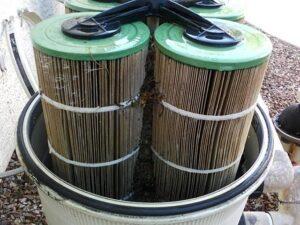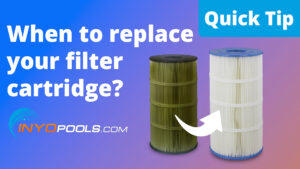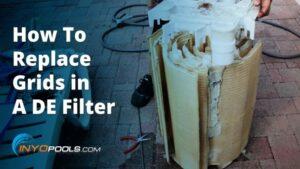If you own a cartridge filter, the one part of maintenance you should earn your black belt in is cleaning your cartridge. A dirty filter cartridge can be the difference between a pristine blue pool and a cloudy, murky, green one. A clogged cartridge will choke your pump’s water flow to a fraction of what it should be. A flow rate drop also lowers the filtration rate of your pump system.
Cleaning involves two levels: you carry out weekly (or semi-weekly) preventative maintenance, and you perform a deep clean, which you may only need once a year. We’ll discuss both.
When Should I Clean My Filter’s Cartridge?
Ask five different pool techs, and you may get five different answers on this. Generally, you’ll know it is time to clean your filter cartridge when the filter PSI rises 8-10 units above your “clean filter” pressure.
**You should note your filter’s ‘CLEAN’ PSI reading and installing a new filter and/or cartridge.**
Some also prescribe that you give your cartridges a hose down every week or so, as part of a cleaning regimen regardless of PSI. If you prefer this method, more power to you; but I find this method inadequate and sometimes wasteful. Depending on the time of year, pollen, sap, and body oils from swimmers can clog your cartridge quicker than usual, causing your cartridge’s cleaning cycle to fall out of line with the needs of your system. And, on the other hand, if your cartridge is not that dirty, then you probably do not have to waste the water hosing it down.
Regular Cleaning
For those times when your filter pressure spikes, there are a few quick ways to get your cartridge sifting smoothly again.
Thumb & Hose
If you prefer a low-tech solution, spraying your cartridge down this way is quick and simple; this method is not recommended for older cartridges.
Gadgets
If you want a little more precision and thoroughness with regard to your cleaning, check out cartridge cleaning gadgets like the Filter Flosser or Aqua Comb. Both of these tools help the coverage of the hose spray concentrate into the folds of the cartridge, where most of the debris is hiding.
Need help finding a replacement Pool Filter Cartridge? Read our guide, How to Identify a Replacement Cartridge for a Pool Filter
Deep Cleaning

There comes a time when a simple hose-down no longer gets your filter down to its normal pressure. A sign that a deep clean is necessary is the filter’s PSI spiking close to “CLEAN ME” levels sooner than normal. In neglected cartridges, this spike of the filter pressure can happen in a few minutes after restarting the pump.
To choose the correct method of cleaning, the key is knowing what type of particulates you are attempting to remove:
- Organic matter
- Algae
- Scale
- Rust stains
- Pool surface material like plaster or fiberglass
Basic Organic Materials – Body Oil, Suntan Lotion, General Dirt & Debris
Chemical: Filter Cleaner, Muriatic Acid, Trisodium Phosphate (TSP)
This category is by far the easiest to clean, but likely takes the longest to build up to a point when a soak is needed. A cartridge will take a couple of seasons before it requires to be deep cleaned. The basic filter cleaner products are meant to target this type of cartridge build-up, but are not ideal for the heavier blockages we’ll discuss.
Algae
Chemical: Muriatic Acid, TSP
The most common remedy for algae-stained cartridges is a muriatic acid bath. You may be familiar with muriatic acid already, as it is also used to lower the pH and alkalinity of pool water. Trisodium phosphate is an all-purpose chemical cleaner that can scrub most stains and debris from your cartridge. These chemicals are super potent, so it is important to take care, and wear protective clothing as suggested in the procedures below.
Scale, Metal Stains, Plaster Dust, Pool Surface Material
Chemical: Muriatic Acid, TSP
If your cartridge shows signs of scale deposits, muriatic acid is your best option for a chemical soak additive.
Less Harsh Alternative
If you are hesitant to use these harsher chemicals like muriatic acid and TSP, a safer home remedy is vinegar. White distilled vinegar is a super versatile household cleaner used to clear up hard water stains, mold mildew, and algae. The downside of vinegar is that you have to use a lot of it. Generally, a one-to-one ratio of vinegar to water is needed to clear your cartridges adequately.
Instructions on how to complete your next chemical soak, courtesy of Unicel Filters, a leading manufacturer of replacement pool filter cartridges and DE grids.

Do you have an interesting or different solution to cleaning your pool cartridges? Let us know about it in the comments.













Leave a Reply